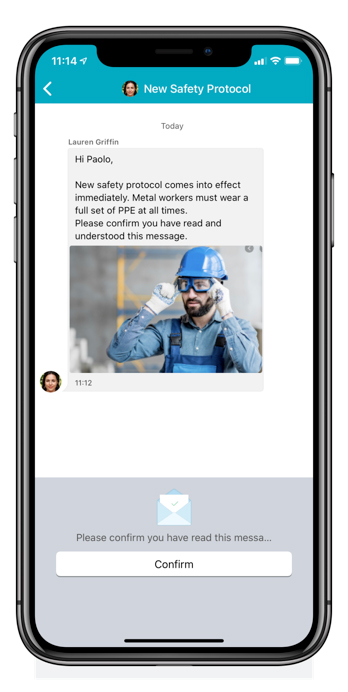During a crisis, leverage real-time, mobile technology to connect frontline workers to ensure safety, engagement, and business continuity.
By: Daniel Sztutwojner, chief customer officer/co-founder of Beekeeper
COVID-19 has been an eye opener and a wake up call for companies unprepared for a crisis. The global pandemic hit fast and hard, redirecting supply chains, disrupting job sites, and forcing companies to pivot operations.
For many industrial organizations, frontline workers have remained at work and leaders have had to figure out how to keep them safe while trying to maintain output levels to meet demand. To achieve these goals, many companies have turned to mobile technology.
81% of people in the United States use mobile devices and half of them are using those devices on the job. Companies in the industrial sphere, heavily supported by frontline employees who don’t have work email, should use those statistics to their advantage and reach these essential workers through the phones in their pockets via a secure workplace app.
Here are four ways companies can leverage mobile technology during COVID-19 to deliver safety information to and stay connected with their frontline workers.
1. Take Advantage of Real-Time, Company-Wide Communication
Industrial organizations have a higher rate of safety incidents than other businesses simply due to the nature of the work. Add external risks, like a global pandemic, and safety becomes an even bigger priority.
Traditionally, communication with frontline industrial workers was limited to messages tacked onto a bulletin board in the common area. But there’s no guarantee that everyone sees each notice. Mobile tools can deliver traceable, company-wide updates to your essential workers in real-time. A mobile workplace also tracks usage data. Managers can keep track of who is opening these messages through the app’s analytics dashboard, so they know if anyone has missed essential communication.

Send real-time messages with a read receipt to ensure every employee receives urgent messages.
2. Keep Workers Updated on Evolving Safety Guidelines
COVID-19 has been a rollercoaster when it comes to recommended safety protocols. While many industrial companies have been deemed essential, and have remained open, they have had to constantly monitor changing safety regulations for their area.
With mobile technology, companies can keep employees informed by creating a dedicated communication stream that is regularly updated with new or revised safety protocols, like how to properly wear a mask and setting schedules to perform temperature checks.
HyLife Foods is one of Canada’s top pork producers. They are a company that continues to operate through the pandemic. Managers have used Beekeeper’s digital workplace to deliver “steady, consistent messaging” to keep every employee updated with the latest guidelines.
According to Dennis Brewster, the Learning and Development Manager at HyLife, “Securing the food chain and producing a quality product while keeping people safe is the primary goal through the COVID-19 crisis. Beekeeper has become our primary driver of all communication, especially health and safety. We have been able to give a consistent and calm message to our entire workforce, whether they are on or off site.”
3. Take a Multi-Channel Communication Approach
While a mobile workplace centralizes information in one place, managers should take a multi-channel approach to ensure priority communication reaches everyone.
A mobile platform will offer multiple options to communicate with employees like:
At Eagle Mine, an operation in Michigan that supplies 1.5 percent of the world’s nickel, leaders adopted Beekeeper’s mobile platform as their primary communication tool. But they supplement their communication streams to ensure every employee receives safety updates wherever they’re located.
“We initiated our crisis management team and communications plan which relied heavily on Beekeeper. We opened a new stream just for COVID-19 updates, pushed that new stream to our TV displays, and updated our paper bulletin boards directing employees and contractors to the new stream,” said Lindsay Bean, Internal Communications and Engagement Advisor at Eagle Mine.
4. Build an Agile, Autonomous Workforce with a Mobile Workplace
Every company should have a crisis communication plan ready to go. Think of it as a roadmap to prepare, respond, and recover from unpredictable scenarios. Emergency preparedness allows a company to pivot to a new operations model. But those plans need to be shared with every person in the organization. Use your mobile workplace platform to align workers with your crisis management strategy. This can foster peace of mind, and create a flexible workforce that can remain productive by easily shifting gears.
Workers are also more agile when they’re digitally empowered. Use your mobile technology to share information they’ll need to make decisions on their own during a crisis. In a recent Harvard Business Review study, researchers found that 87% of companies believe a more autonomous frontline workforce that is empowered to make decisions in real time will increase the overall success of the organization.
Trusting frontline employees with the digital capability and information to become problem solvers builds engagement, but it also creates a confident, agile workforce that’s prepared and ready to pivot when a crisis impacts operations.

Daniel Sztutwojner
Daniel Sztutwojner is chief customer officer and co-founder of Beekeeper, the single point of contact for your frontline workforce. Beekeeper’s mobile platform brings communications and tools into one place to improve agility, productivity, and safety. Daniel is passionate about helping businesses operate more efficiently.
Scott Ellyson, CEO of East West Manufacturing, brings decades of global manufacturing and supply chain leadership to the conversation. In this episode, he shares practical insights on scaling operations, navigating complexity, and building resilient manufacturing networks in an increasingly connected world.